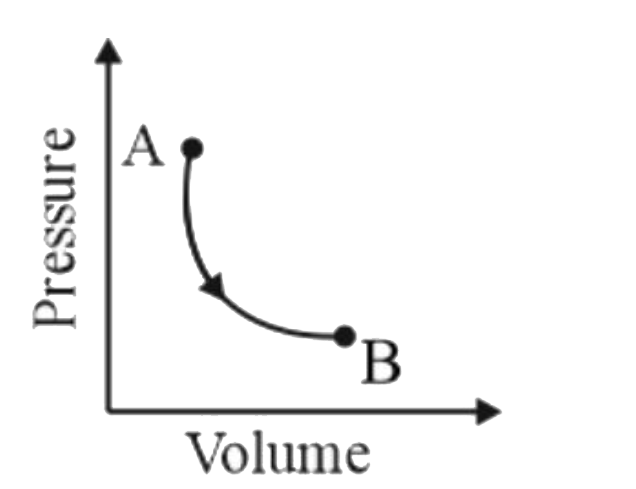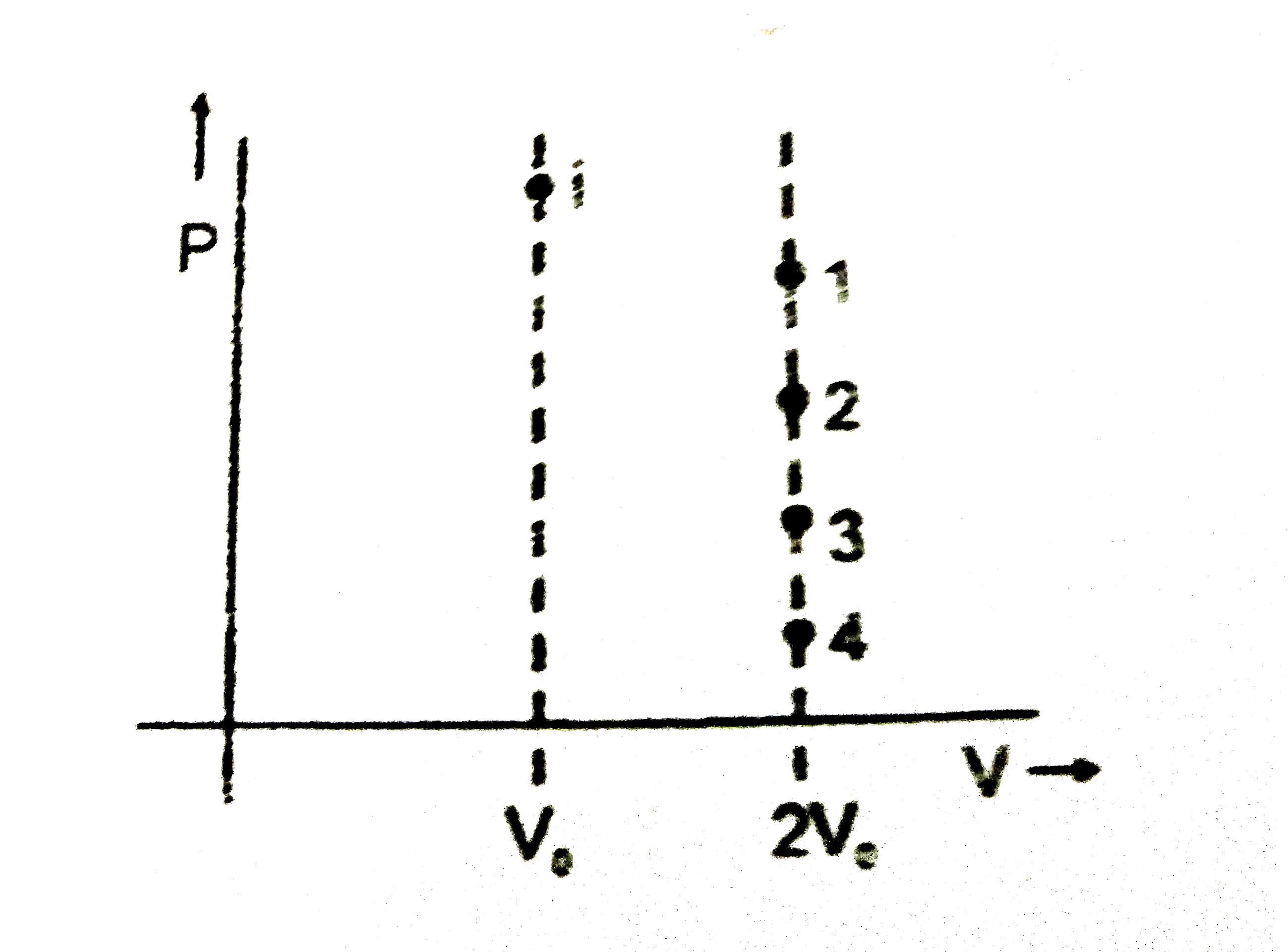The pressure volume work for an ideal gas can be calculated by using the expression . The work can also be calculated from the pV-plot by using the area under the curve within the specified limits. When an ideal gas is compressed (a) reversibly or (B) irreversibly from volume to choose the correct option.
W (reversible) = W (irreversible)
W (reversible) W (irreversible)
W (reversible) W (irreversible)
W (reversible) W (irreversible)
The correct Answer is:B
To solve the question regarding the work done during the compression of an ideal gas, we will analyze the work done in both reversible and irreversible processes.
1. Understanding Work Done:
The work done on or by a gas during a volume change can be expressed mathematically as:
w=−∫VfViPexdV
where Pex is the external pressure and Vi and Vf are the initial and final volumes, respectively.
2. Reversible Process:
In a reversible process, the gas is compressed slowly, and the external pressure Pex is always equal to the internal pressure of the gas. This means the process follows a specific path on the pressure-volume (PV) diagram, resulting in a curved line. The work done can be calculated as the area under this curve.
3. Irreversible Process:
In an irreversible process, the gas is compressed rapidly, and the external pressure is constant (often taken as the final pressure of the gas). This results in a straight line on the PV diagram. The work done in this case is represented by the area under the straight line from Vi to Vf.
4. Comparing Work Done:
- For the reversible process, the work done is represented by the area under the curve, which is generally less than the area under the straight line for the irreversible process.
- For the irreversible process, since the external pressure is constant and typically higher than the internal pressure during compression, the work done is greater.
5. Conclusion:
From the analysis, we can conclude that:
Wreversible<Wirreversible
Therefore, the correct option is that the work done in a reversible process is less than that in an irreversible process.
Final Answer:
The correct option is B: Work done in a reversible process is less than work done in an irreversible process.
The work done on or by a gas during a volume change can be expressed mathematically as:
w=−∫VfViPexdV
where Pex is the external pressure and Vi and Vf are the initial and final volumes, respectively.
In a reversible process, the gas is compressed slowly, and the external pressure Pex is always equal to the internal pressure of the gas. This means the process follows a specific path on the pressure-volume (PV) diagram, resulting in a curved line. The work done can be calculated as the area under this curve.
In an irreversible process, the gas is compressed rapidly, and the external pressure is constant (often taken as the final pressure of the gas). This results in a straight line on the PV diagram. The work done in this case is represented by the area under the straight line from Vi to Vf.
- For the reversible process, the work done is represented by the area under the curve, which is generally less than the area under the straight line for the irreversible process.
- For the irreversible process, since the external pressure is constant and typically higher than the internal pressure during compression, the work done is greater.
From the analysis, we can conclude that:
Wreversible<Wirreversible
Therefore, the correct option is that the work done in a reversible process is less than that in an irreversible process.
The correct option is B: Work done in a reversible process is less than work done in an irreversible process.
Topper's Solved these Questions
Similar Questions
Calculate the work done in calories when 5 moles of an ideal gas are compressed isothermally and reversibly from a pressure of 1.5 atm to 15 atm at 27∘C.
View SolutionFor an ideal gas, the work of reversible expansion under isothermal condition can be calculated by using expression =−nRTln.VfVi. A sample containing 1.0 mol of an ideal gas is expanded isothermally and reversible to ten times of its original volume, in two separate experiments. The expansion is carried out at 300 K and at 600 K respectively. Choose the correct option
View Solution
Knowledge Check
The pressure-volume work for an ideal gas can be calculated by using the expression W=−∫VfViPexdV. The work can also be calculated from the pV - plot by using the area under the curve within the specified limits. When an ideal gas is compressed (i) reversibly or (ii) irreversibly from volume Vi to Vf. Choose the correct option.
AWreversible=WirreversibleBWreversible<WirreversibleCWreversible>WirreversibleDWreversible=Wirreversible+PexΔV
The pressure and volume of an ideal gas are related as pα1v2 for process A→B as shown in figure . The pressure and volume at A are 3p0andv0 respectively and pressure B is p0 the work done in the process A→B is found to be [x−√3]p0v0 find

View SolutionA gaseous sample is generally allowed to do only expansion/compression type work against its surroundings The work done in case of an irreversible expansion ( in the intermediate stages of expansion/compression the states of gases are not defined). The work done can be calculated using
dw=−PextdV
while in case of reversible process the work done can be calculated using
dw=−PdV where P is pressure of gas at some intermediate stages. Like for an isothermal reversible process. Since P=nRTV, so
w=∫dW=−vf∫vinRTV.dV=−nRTln(VfVi)
Since dw=PdV so magnitude of work done can also be calculated by calculating the area under the PV curve of the reversible process in PV diagram.
If four identical samples of an ideal gas initially at similar state (P0,V0,T0) are allowed to expand to double their volumes by four different process.
I: by isothermal irreversible process
II: by reversible process having equation P2V= constant
III. by reversible adiabatic process
IV. by irreversible adiabatic expansion against constant external pressure.
Then, in the graph shown in the final state is represented by four different points then, the correct match can be

View SolutionGraphically show the total work done in an expansion when the state of an ideal gas is changed reversibly and isothermally from (pi,Vi) to (pf,Vf). With the help of a pV plot compare the work done in the above case with that carried out against a constant pressure pf.
View SolutionIf a gas of a volume V1 at pressure p1 is compressed adiabatically to volume V2 and pressure p2, calculate the work done by the gas.
View SolutionA gas is expanded from volume V1 to V2 through three different process:
a. Reversible adiabatic
b. Reversible isothermal
c. Irreversible adiabatic (against a constant external pressure Pex)
The correct option is
View SolutionOne mole of an ideal gas is expanded from a volume of 3L to 5L under a constant pressure of 1 atm. Calculate the work done by the gas.
View SolutionA sample of ideal gas undergoes isothermal expansion in a reversible manner from volume V1 to volume V2. The initial pressure is P1 and the final pressure is P2. The same sample is then allowed to undergoes reversible expansion under adiabatic conditions from volume V1→V2. The initial pressure being same but final pressure is P3.
The work of expansion in adiabatic process (wadi) is related to work of expansion in isothermal process (wiso) is
View Solution
